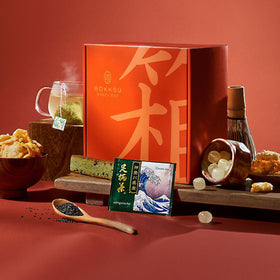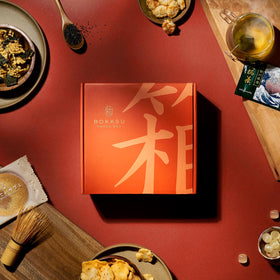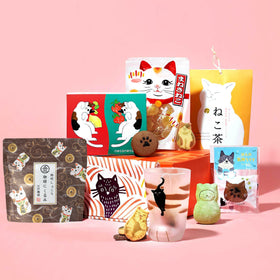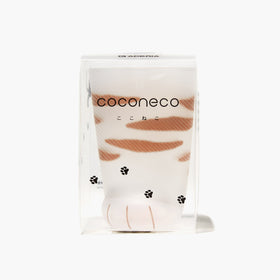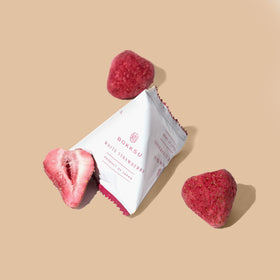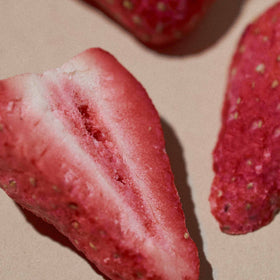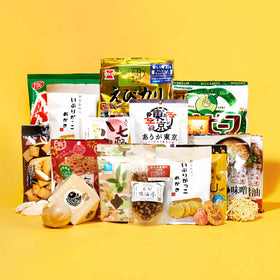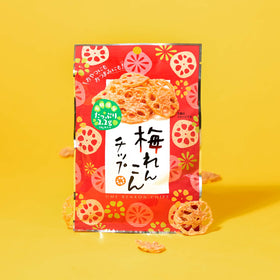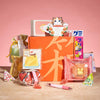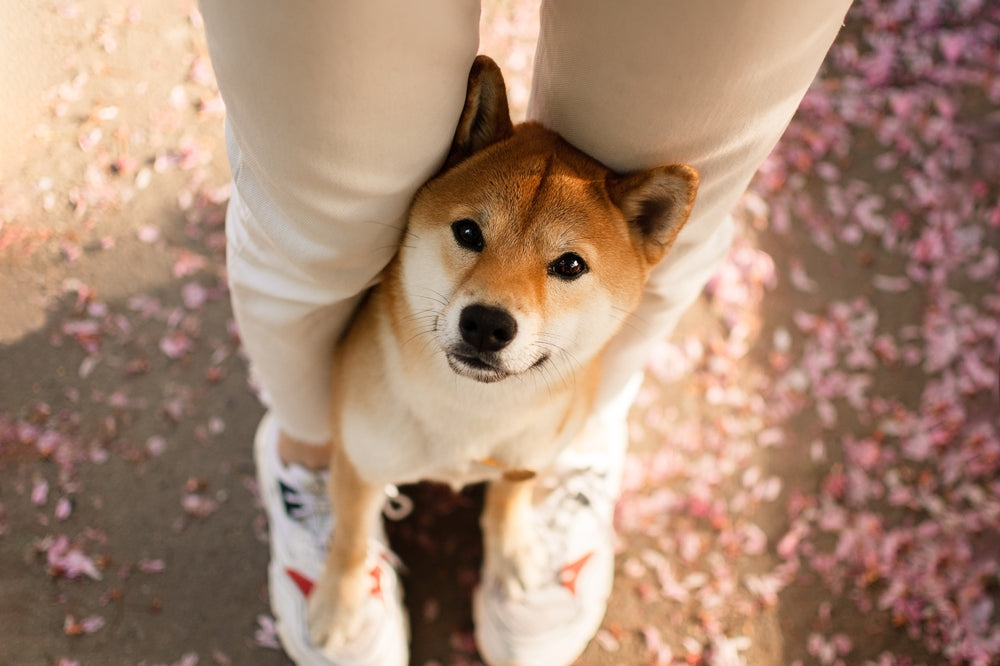Chrysanthemum Season: Japan’s Imperial Flower in Design
The Chrysanthemum’s Imperial Legacy in Japan

Among Japan's most celebrated fall flowers, few carry as much cultural weight as the chrysanthemum, or kiku. For centuries, it has stood as a symbol of longevity, rejuvenation, and renewal. Its deep ties with the imperial family and the Japanese imperial court have elevated a seasonal bloom, transforming it into a lasting emblem of nobility and high status.
This connection is most famously seen in the imperial seal—a striking yellow or orange chrysanthemum with 16 double petals, outlined in black or red against a dark background. Known as the 16-petaled chrysanthemum crest, it has represented the imperial household since the Kamakura period (1185–1333). The flower’s association with sovereignty also lives on in the Chrysanthemum Throne, which refers not only to the Emperor of Japan's actual seat but also to the monarchy itself. Representing the unbroken lineage of the Yamato Dynasty, the world’s oldest continuous hereditary monarchy, the throne links the chrysanthemum’s timeless beauty with the enduring authority and tradition of Japan’s imperial institution.
The chrysanthemum further appears on official symbols of state, from the 50-yen coin to the cover of the Japanese passport, reinforcing its role as a national icon. Today, its significance endures: it is celebrated in festivals across Japan and continues to inspire intricate designs in food, textiles, and traditional crafts, proving that its beauty and cultural resonance remain as vibrant and meaningful as ever.
Kiku in Japanese Culture and Chrysanthemum Festivals

As autumn unfolds in Japan, the landscape bursts into bright shades of red, orange, and gold, painted not only by cosmos flowers and red spider lilies but also by the stately chrysanthemum. Blooming from September through November, chrysanthemums are a quintessential symbol of the season, with late-blooming varieties cultivated to reach their peak in mid-October, creating some of the the most brilliant displays of autumn flowers. While Chrysanthem Day, or Kiku no Sekku, falls on September 9th, the flowers are often at their most breathtaking later in the season, when gardens, parks, and shrines showcase them in full splendor.
The chrysanthemum's cultural presence is perhaps most vividly experienced in Japan's annual Chrysanthemum Festival, held on September 9th. As one of the country’s Five Seasonal Festivals (Gosekkaku), it is an ancient tradition that marks the change of seasons. Shinto shrines and Buddhist temples hold rituals honoring the flower, offering prayers for health, longevity, and well-being. Beyond this official observance, chrysanthemum festivals take place in communities across Japan, where the blooms are celebrated through exhibitions, illuminations, and cultural performances.
Festivals like the Nanyo Chrysanthemum Festival in Yamagata, the Shinjuku National Garden Chrysanthemum Exhibition in Tokyo, and the Kiku Niungyo (Chrysanthemum Doll) festivals highlight the artistry of chrysanthemums through stunning displays. Intricate kiku-ningyo, or chrysanthemum dolls, transform individual flowers into lifelike figures and elaborate scenes, while other arrangements showcase innovative techniques in shaping, layering, and coloring the blooms. Together, these festivals and displays paint a vivid picture of autumn in Japan, celebrating not only the season’s natural beauty but also the country’s deep cultural heritage.
The Art of Floral Motifs in Japanese Design

In Japanese design, the chrysanthemum holds a special place as one of the most enduring and meaningful floral motifs. Rooted in hanakotoba, the language of flowers, it carries deep symbolism, representing royalty, longevity, and renewal. Because of these auspicious associations, the chrysanthemum has long appeared in traditional crafts, adorning kimonos, obis, hair accessories, and fine porcelains. In kimono design especially, floral patterns are more than decoration—they mark the seasons and reflect cultural values. Chrysanthemums often feature in autumn attire, honoring both the season and the flower’s noble symbolism. In this way, the chrysanthemum extends beyond gardens and festivals, woven into the very fabric of Japanese culture as a timeless emblem of beauty and meaning.
Ceramics in Bloom: Kiku-Inspired Tableware

Beyond textiles, the chrysanthemum has also flourished in Japan’s decorative arts, where its intricate, layered form lends itself beautifully to ceramics and tableware. Artisans across the country have reimagined the flower’s elegance in countless ways—from the bold blue-and-white Tobe ware of Ehime Prefecture, with vases and plates adorned in hand-painted chrysanthemums, to the versatile charm of Minoyaki ceramics, where glazed floral motifs suit both everyday use and seasonal dining. In the Kakiemon style, chrysanthemums appear in vibrant overglaze designs set against pristine white porcelain, capturing a balance of delicacy and vitality. Sculptural interpretations such as kikuwari, where porcelain is shaped into pleated forms resembling chrysanthemum petals, further showcase the flower’s quiet grace. Painted, carved, or molded, chrysanthemum-inspired ceramics bring a timeless refinement to the table, making them especially fitting for autumn dining and seasonal displays.
Sweet Traditions: Chrysanthemum-Themed Wagashi

In Japan, the chrysanthemum is valued not only for its beauty but also as an edible flower, often enjoyed as a fragrant tea made by steeping the blossoms in hot water. In Yamagata Prefecture, it takes on a culinary role in enmeiraku—also known as mottenohoka—a signature summer and autumn dish from Tsuruoka. Here, the petals are served cold and marinated in a light, sweet-sour sauce that brings out their refreshing flavor.
This seasonal flower also finds its way into wagashi, serving as both inspiration and ingredient. The refined Yaenokiku sweet pairs a crisp, chrysanthemum-shaped wafer with white bean paste delicately blended with Abokyu chrysanthemum petals, while the Nanbugiku manjū, a specialty of Hachinohe, folds petals into its dough to add subtle floral notes to the traditional steamed bun. These chrysanthemum-themed confections capture the spirit of autumn, making them a delightful treat to share with friends and family or as a thoughtful omiyage to bring home from a trip.
Textiles with a Seasonal Touch

Chrysanthemums hold a special place in Japan’s traditional kogei crafts, especially within the world of textile arts, where they symbolize both autumn and longevity. Their elegant petals translate beautifully into embroidery, prints, and woven designs that bring a seasonal touch to daily life. From kimono patterns marking the turn of the seasons to furoshiki wrapping cloths, scarves, and decorative fabrics, chrysanthemum motifs appear in many forms—sometimes bold and vibrant, other times delicate and refined. Whether stitched in gold thread, brushed in indigo, or printed in repeating patterns, these designs reflect not only the flower’s beauty but also its cultural meaning. Today, chrysanthemum-inspired textiles continue to add refinement and symbolism to modern lifestyles, carrying forward a timeless tradition in ways that feel both practical and poetic.
The Seasonal Color Palette of Chrysanthemums: Japan’s Autumn Cherry Blossoms

Chrysanthemums, or kiku, are appreciated in Japan not only in gardens and festivals but also in home décor and gift design. They appear in a wide range of colors—white, yellow, orange, red, pink, purple, and bronze, often in bi-color varieties—that align naturally with the autumn season. Yellow chrysanthemums, once associated with the emperor, convey dignity and tradition. Purple, historically reserved for nobility, is now linked with thoughtfulness, care, and quiet confidence. Orange and bronze varieties suggest vitality and warmth, echoing the atmosphere of autumn evenings. These colors are often combined with other seasonal elements such as Japanese pampas grass, commonly displayed with kiku during autumn festivals.
Chrysanthemums as Autumn Flowers in Modern Japanese Art and Gifts

In modern Japan, artisans continue to reinterpret the chrysanthemum motif, blending tradition with contemporary design. Delicate glassware etched with kiku patterns reflects light like autumn petals, while stationery decorated with stylized blooms brings a seasonal elegance to everyday writing. Jewelry designers also reimagine the flower in sleek metals or pair it with gemstones, turning its timeless form into wearable art. These pieces are not only decorative but also carry the chrysanthemum’s enduring symbolism of longevity, elegance, and thoughtfulness. For those looking for chrysanthemum gifts, Japan offers a wide selection of modern designs that respect tradition while blending seamlessly into contemporary life.
Gifting Etiquette: When to Give Chrysanthemum-Themed Gifts

In Japan, gifting etiquette places strong emphasis on symbolism, and chrysanthemums carry particular cultural weight—making color choice just as important as the gift itself. White chrysanthemums, for instance, are associated with funerals and memorials, symbolizing grief and death, and are therefore avoided in casual gifting. Instead, vibrant shades like yellow, red, orange, or purple are preferred, each carrying its own meaning: yellow for happiness and respect, red for love and vitality, purple for nobility and thoughtfulness, and orange for joy and energy. These colors can be thoughtfully matched to the occasion, whether it’s an autumn gathering, a seasonal greeting, or a celebration of longevity and well-being. Chrysanthemum-themed gifts—such as decorative textiles, glassware, or stationery—become especially meaningful when chosen with both symbolism and season in mind, creating offerings that feel elegant, respectful, and personal.
Bringing Kiku Home: Curated Autumn Floral Finds

Just as chrysanthemums have long symbolized elegance and meaning in Japanese culture, Bokksu Boutique makes it easy to bring that same timeless beauty into your own home. In addition to authentic Japanese snacks, Bokksu offers a curated collection of homeware and gifts that celebrate the artistry of flowers. The Champ De Fleur Bath Petal Gift Box, for example, recreates the luxury of a resort spa with delicate soap petals that look and feel like real blooms, while the Fleur La Fée Flower Bath Powder blends rose and lilac fragrance with soothing properties to ease fatigue, stiffness, and stress. For the table, the Sakura Blossom Bowl Set—a handcrafted four-piece glassware collection in soft shades of pink and purple—offers versatile elegance, perfect for serving snacks, displaying jewelry, or simply adding a touch of seasonal charm to your space. With Bokksu’s thoughtfully selected pieces, you can enjoy the beauty of kiku and other floral motifs wherever you are.
Author Bio




